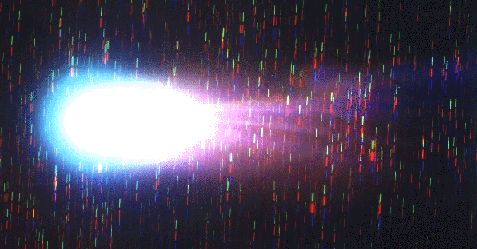Astronomy Picture of the Day
Discover the cosmos!
Each day a different image or photograph of our fascinating universe is
featured, along with a brief explanation written by a professional
astronomer.
March 29, 1996

The Colors of Comet Hyakutake
Credit:
Colour Photograph from UK Schmidt plates by David Malin
Copyright: Anglo-Australian Observatory
Explanation:
The colors of
Comet Hyakutake are caused by the action of sunlight on
the dust and gas produced by the warming nucleus.
The microscopic dust particles
reflect sunlight while
the sun's ultraviolet radiation excites and ionizes
the gas molecules causing them
to glow or fluoresce in a range of visible colors.
This enhanced color picture
reveals subtle
color changes across the cometary coma and a faint multicolored tail.
It was made on the night of March 18-19 by combining separate
green, red, and blue photographs, each about a 15 minute exposure.
Some of the color features in the tail
may well represent real changes in its structure from one exposure
to the next.
The colored star trails,
created as the
Anglo-Australian Observatory's
UK Schmidt Telescope tracked the rapidly moving comet,
indicate the order of the separate exposures.
The cometary hues revealed here can not be seen directly due to
the human eye's lack of
color vision at the low light levels involved.
Latest Comet Hyakutake images:
JPL,
Fayetteville
Observer-Times,
NASA's Night of
the Comet,
ICSTARS,
Crni Vrh Obs.,
Cent. Mich U.
Tomorrow's picture: An Extreme UltraViolet View of Comet Hyakutake
Peter McCullough's March 26th Comet Mpeg
Comet Hyakutake Finder Chart
| Archive
| Index
| Search
| Glossary
| Education
| About APOD |




Authors & editors:
Robert Nemiroff
(GMU) &
Jerry
Bonnell (USRA).
NASA Technical Rep.:
Sherri
Calvo.
Specific rights apply.
A service of:
LHEA
at
NASA/
GSFC




